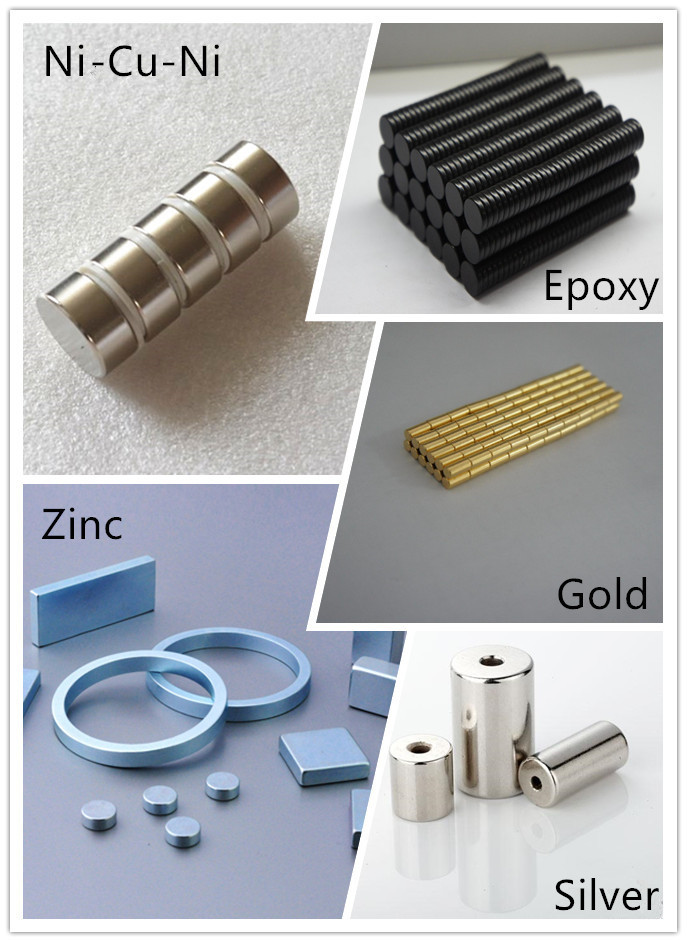Plating neodymium magnets is an important process to protect the magnet from rusting. Plating Neodymium magnets is an electrolytic based process and can not be done after the magnet has been magnetized or “charged”. All Neodymium Iron Boron magnets mused be plated to avoid oxidization.
NdFeB magnets will oxidize (rust) if left exposed. When a plating wears down or cracks, the exposed area will oxidize. An oxidized area will not result in complete degradation of the magnet, only the oxidized area will lose its strength. However the magnet will lose some structural integrity and become more susceptible to breakage.
Depending on shape, permanent magnet substrate is brittle. A multilayer coating like nickel or zinc improves the magnets resistance to chipping and wear, particularly around corners. Plating vary in their tolerance of different harsh chemicals and abrasion. Salt and humidity in regions near the ocean are commonly overlooked when selecting a plating. Be sure to consider the magnets environment when selecting a plating.
The most common type of plating for neodymium magnets Nickel (Ni-Cu-Ni) Intended for indoor use. It has proven to be very resilient when subjected to normal wear and tear. However it will corrode outdoors in prolonged exposure to salt water, salty air, or harsh chemicals. Here is the plating that available for the Neodymium magnet.

- Nickel (NICUNI)
The most common plating. Ni-Cu-Ni is a durable 3 layer (nickel, copper, nickel coating). Great for indoor use. They may be used outdoors if protected from rain and humidity. Good abrasion resistance.
- Zinc Plating (Zn)
The 2nd most common magnet plating. Zinc is a standalone (one layer) plating. Zinc is self- sacrificing, meaning when it starts to oxidize the outside turns white creating a durable layer of protection.
- Gold (Ni-Cu-Ni-Au)
A very thin / cosmetic layer of gold. Usually produced with an underlying layer of nickel to create a brighter finish. Works very well in water applications. The gold layer is very thin and adds only a few cents per magnet.
- Black Epoxy (Ni-Cu-BE)
Black Epoxy plating is consists of 3 layers Nickel, Copper, and Epoxy exposed as the top layer. Great for outdoor applications. However, black epoxy is not as abrasion resistant as other plating. In harsh conditions the epoxy layer may be scratched off to expose the copper layer underneath.
- Raw Epoxy (BE)
Raw Epoxy is designed specifically for gluing applications where the magnet requires a good adhesion to epoxy glue. This coating consists of one layer of epoxy covering the magnet.
- Plastic (ABS)
ABS Plastic is highly corrosion resistant. This coating requires an injection mold to be created in order to encase the magnet. The plastic shell needs to be thicker than other coatings so the plastic can flow during the injection process. Multiple colors available.
- Teflon® (PTFE)
Teflon is very resilient and can withstand harsh environments. It is highly corrosion resistant. An injection mold is required to create the shell around the magnet. There will be a noticeable mold seam around the magnet where the injection mold separates.
- Everlube® 6155
Everlube 6155 is a aluminized barrier coating specially formulated to maximize adhesion and corrosion protection when applied to rare earth magnets. The coating is very durable and provides excellent chemical and corrosion resistance.
- Xylan®
Xylan coatings are fluorocarbon coatings that contain dry lubricants. Slippery and highly corrosion resistant. Multiple colors available.
By : Josevan Setiaputra Hong
Reference:



0 Comments